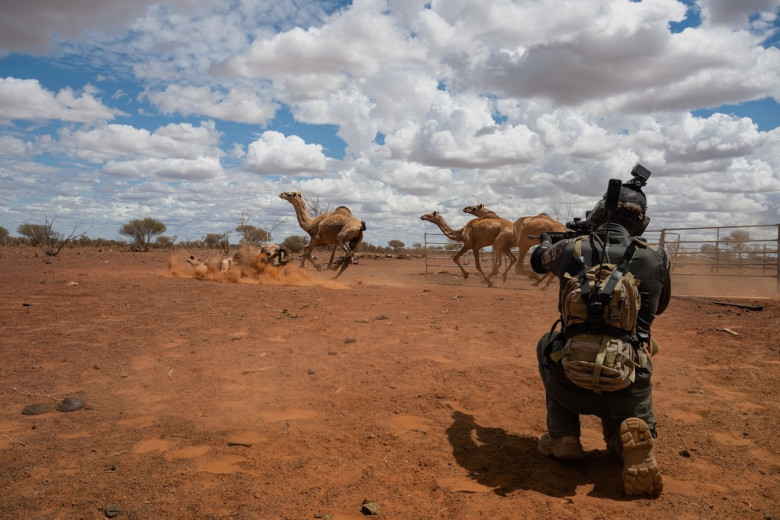The Camel Conundrum: Australia’s Battle Against Invasive Giants

Australia, a land characterized by its unique wildlife and expansive landscapes, is facing a growing problem. Feral camels, massive creatures tipping the scales at about 1,000 pounds, are invading the Australian outback in unprecedented numbers. Initially introduced in the 19th century to assist colonial explorers in traversing the vast, arid interior, these once-helpful animals have now turned into a destructive force, threatening the very ecosystems they once helped navigate. Among the people on the front lines of this battle is Jack Carmody, who has harnessed the power of social media to document his challenging yet vital work on his ranch, Prenti Downs.
Spanning over 1,500 square miles—the equivalent of Rhode Island—Prenti Downs is a cattle station located in Western Australia. Here, Carmody engages in the demanding work of maintaining his cattle operation—a mix of herding, repairs, and, unfortunately, warfare against invasive species. His YouTube channel, "Jack Out The Back," has attracted a significant following, particularly for its raw and honest portrayal of life in the outback. His most popular videos showcase his ongoing struggle against feral camels, which are wreaking havoc on his land and livelihoods.
The feral camel population in Australia has exploded, with estimates ranging from several hundred thousand to possibly a million. These formidable animals reproduce quickly, with females capable of birthing every two years and living up to 40 years in the wild. Under ideal conditions, their numbers can double in a mere nine years, creating a relentless cycle of invasion. They travel in herds that can vary from small clusters to hundreds of individuals, trampling fragile ecosystems and causing extensive damage to agricultural infrastructure. Each year, Carmody finds himself on the frontlines, culling nearly 800 camels to mitigate their destructive impact. For him, this isn't merely a matter of survival; it's akin to "weeding the veggie patch," a practical solution to a pressing problem.
However, the reality is grim. By disrupting the delicate balance of local wildlife, these camels are not just a nuisance; they pose a serious threat to the sustainable living practices of Indigenous communities. Their appetite is insatiable: an adult camel can drink up to 50 gallons of water in a single day. This becomes a dire issue when they invade areas lacking natural water sources, tearing up pipes and obliterating vital infrastructure meant to supply water to both livestock and local inhabitants. The consequences are stark; camels often leave behind puddles poisoned by their droppings, turning life-giving water into a toxic hazard.
For Carmody and others in the region, the urgent need to address the camel crisis can sometimes overshadow the intricacies of dealing with such a unique challenge. Not only do these creatures strip away essential resources from other animals and livestock, but they also destabilize sand dunes, leading to further erosion and ecological degradation. As they consume more vegetation, the fragile ecosystems suffer, making it increasingly difficult for local wildlife and traditional ways of living to sustain themselves.
Carmody’s documented experiences provide key insights into the realities of farming amid nature’s challenges. His channel offers a rare glimpse into the duality of existence in the outback—where rugged beauty meets harsh realities. Videos featuring the culling process have drawn both supporters and critics, igniting discussions surrounding ethical solutions and long-term plans for wildlife management. While the immediate action of culling may seem extreme to some, for Carmody it's a necessary measure to protect his property and its resources.
Interestingly, the YouTube phenomenon adds an unexpected layer to this narrative. Jack’s platform facilitates a broader conversation about the impact of invasive species in Australia and raises awareness around the significance of sustainable practices. While some might tune in for the sheer thrill of the hunt, others find themselves informed about the complex relationship between the land, its people, and the introduced species.
The fight against feral camels is emblematic of the broader issues faced by those living in rural Australia: balancing tradition with modern realities, environmental stewardship with the demands of agriculture. As the numbers of these giants continue to rise, innovative solutions will be essential. Whether through alternative management strategies or community involvement, it is crucial to seek effective methods that do not compromise the delicate fabric of Australia’s ecosystems.
As Jack Carmody continues to battle these giants of the outback, he remains aware that every decision carries weight. The journey he shares with his followers is not just about culling camels; it is a story of resilience, adaptation, and the ongoing quest for harmony between humanity and nature. Like the changing tides of the Australian landscape, the situation requires not just a reaction but a thoughtful approach that respects both the natural world and the communities embedded within it.
Ultimately, as Australia grapples with its camel crisis, Jack’s candid storytelling highlights an enduring truth: while we may fight against the tide of change, it is essential to find sustainable ways to coexist with our environment. Through understanding and action, there lies hope for a harmonious balance in the rugged Australian outback—a sort of peace that not only benefits the land but also enriches the lives of its caretakers.













Comments
0 comment